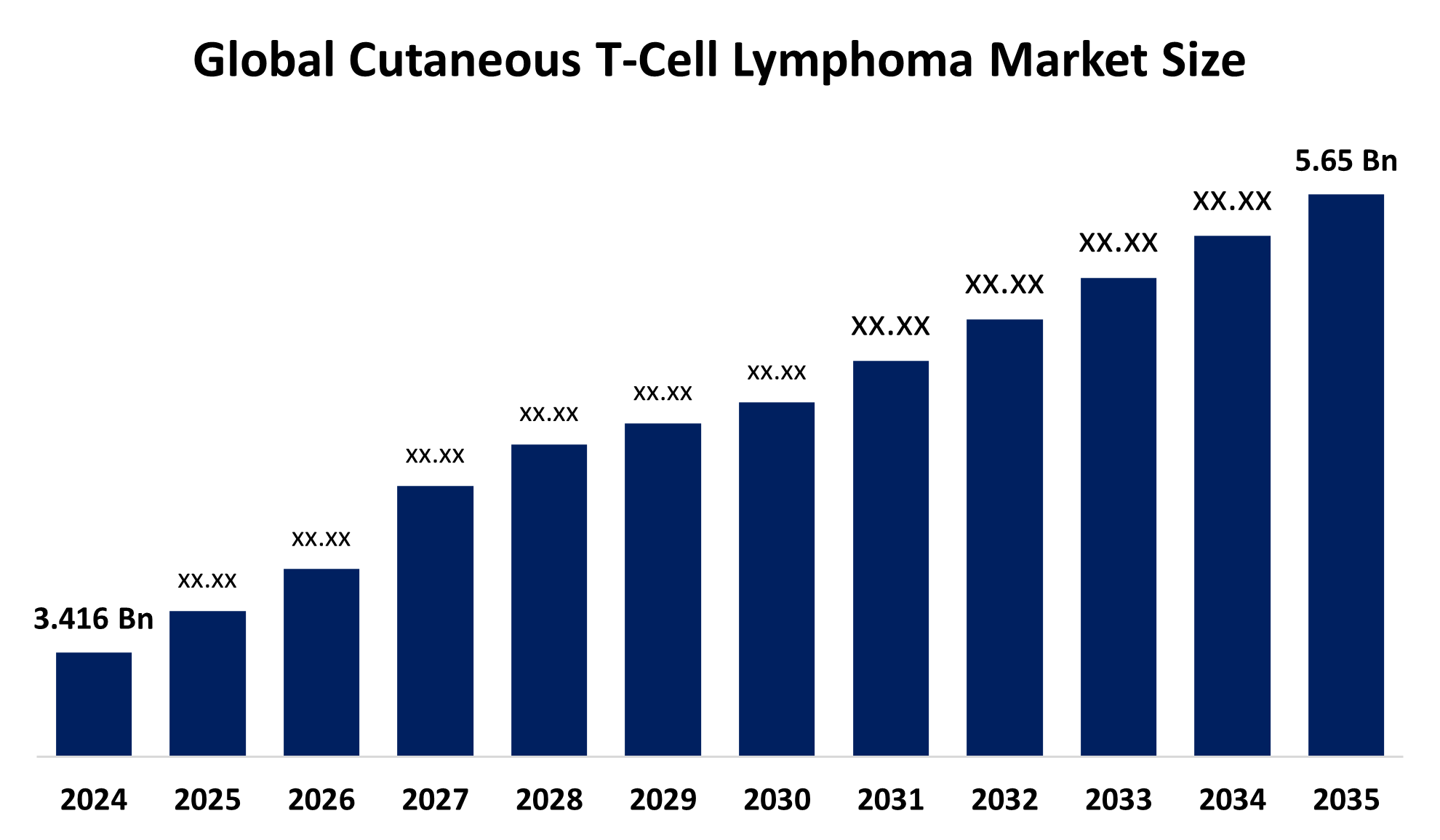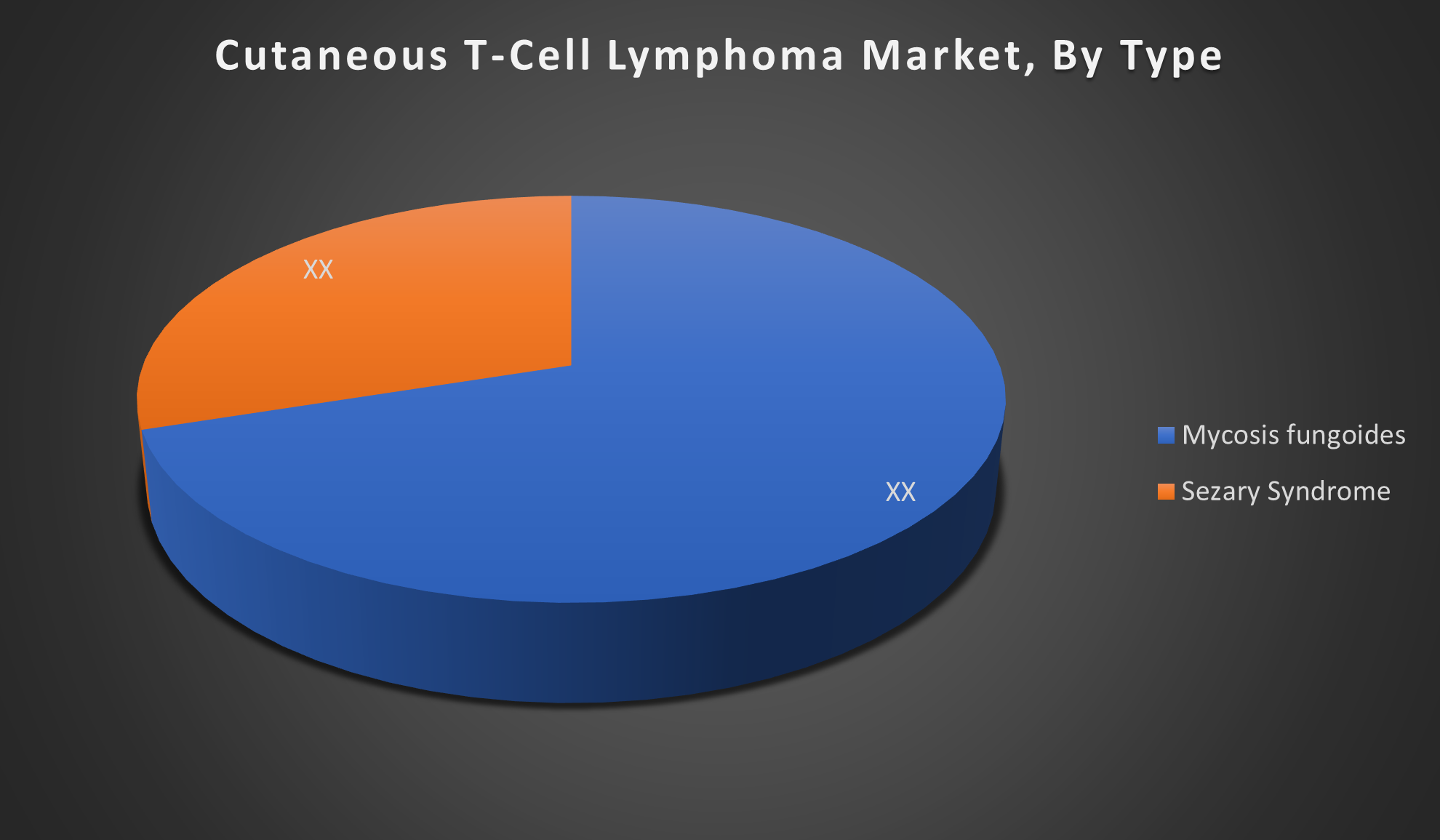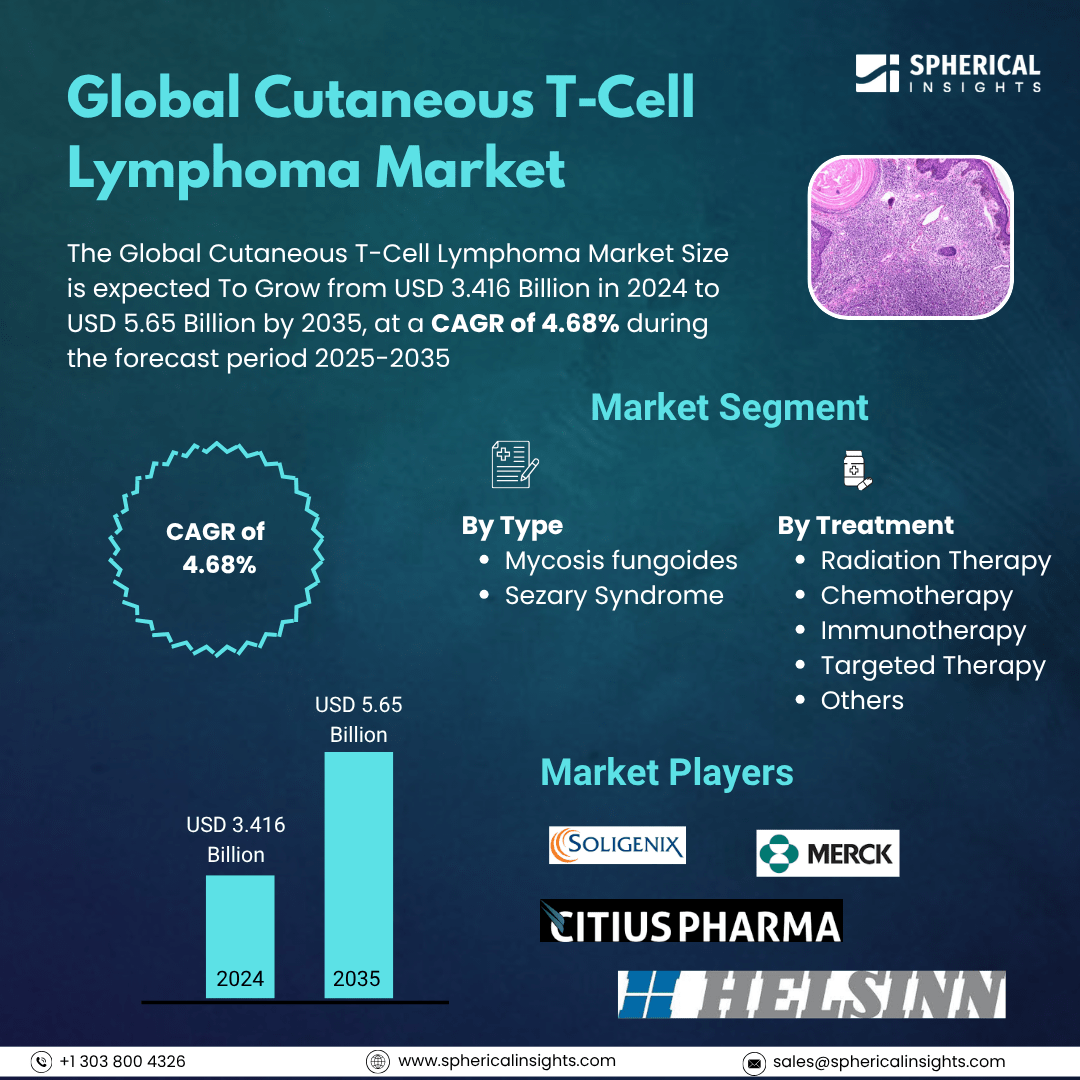- As per Spherical Insights & Consulting, The Global Cutaneous T-Cell Lymphoma Market Size is expected To Grow from USD 3.416 Billion in 2024 to USD 5.65 Billion by 2035, at a CAGR of 4.68% during the forecast period 2025-2035, owing to the launch of new therapies in the market and the rise in the number of cases.
- The leading Cutaneous T-Cell Lymphoma Market Companies such as Helsinn Healthcare SA, Kyowa Hakko Kirin, Pfizer, Bristol Myers Squibb, Seattle Genetics, Bausch Health Companies, Medivir AB, 4SC AG, Innate Pharma, BeiGene, Mundipharma International, and Galderma SA, and Others.

Cutaneous T-Cell Lymphoma Treatment Market: Understanding and Treatment Algorithm:
Cutaneous T-cell lymphoma (CTCL) is a rare type of non-Hodgkin lymphoma that originates in T-cells and primarily affects the skin. It causes red, scaly patches, tumors, or widespread redness. The most common subtypes are mycosis fungoides and Sézary syndrome. CTCL progresses slowly and often requires long-term treatment.
Cutaneous T-Cell Lymphoma Diagnosis
Diagnosis involves a combination of skin biopsies, blood tests, and imaging studies. Dermatologists examine skin lesions, and pathologists analyze tissue samples. Flow cytometry and molecular tests may detect abnormal T-cells. Diagnosis can be challenging due to symptom overlap with benign skin conditions, requiring repeated assessments for confirmation.
Cutaneous T-Cell Lymphoma Treatment
Treatment for cutaneous T-cell lymphoma (CTCL) depends on the stage and subtype. Early-stage CTCL may be managed with topical steroids, phototherapy, or skin-directed therapies. Advanced stages often require systemic treatments like retinoids, chemotherapy, biologics, or targeted therapies. Treatment aims to control symptoms, slow progression, and improve quality of life.
Cutaneous T-Cell Lymphoma Epidemiology
The disease epidemiology covered in the report provides historical as well as forecasted epidemiology segmented by Total Diagnosed Incident Population of Cutaneous T-Cell Lymphoma, Gender-specific Diagnosed Incidence of Cutaneous T-Cell Lymphoma, Type-specific Diagnosed Incidence of Cutaneous T-Cell Lymphoma, Age-specific Diagnosed Incidence of Cutaneous T-Cell Lymphoma, Diagnosed Incident Population based on Primary Site of Cutaneous T-Cell Lymphoma, and Diagnosed Incident Population based on Histologic Classification of Cutaneous T-Cell Lymphoma Tumour in the global market covering North America, Europe, Asia-Pacific, Latin America, the Middle East, and Africa from 2024 to 2035.
Principal Insights
This section offers a global overview of cutaneous T-cell lymphoma epidemiology in major markets worldwide.
Country Wise- Cutaneous T-Cell Lymphoma Multiforme Epidemiology
- The epidemiology segment provides Cutaneous T-Cell Lymphoma prevalence data and findings across key regions worldwide, including North America, Europe (Germany, France, Italy, Spain, and the United Kingdom), Asia-Pacific (including Japan), Latin America, the Middle East, and Africa.
Cutaneous T-Cell Lymphoma: Recent Developments:
In June 2025, Citius Oncology announced that it completed commercial-scale manufacturing of LYMPHIR, secured distribution agreements, and finalized supply chain and reimbursement preparations.
Cutaneous T-Cell Lymphoma Marketed Drugs:
- LYMPHIR (Denileukin Diftitox-cxdl): Citius Pharmaceuticals
LYMPHIR is a recombinant fusion protein targeting the IL-2 receptor (CD25) on malignant T-cells. It is FDA-approved for patients with relapsed or refractory CTCL.
- Targretin (Bexarotene): Bausch Health Companies
Targretin is a retinoid X receptor (RXR) agonist used for the treatment of CTCL in patients refractory to at least one prior systemic therapy. It modulates gene expression to induce apoptosis and inhibit cell proliferation. It is available in both oral and topical formulations
- Zolinza (Vorinostat): Merck & Co.
Vorinostat is a histone deacetylase (HDAC) inhibitor approved for the treatment of cutaneous manifestations of CTCL in patients with progressive, persistent, or recurrent disease after systemic therapies. It alters gene expression by inhibiting histone deacetylation, leading to cancer cell death.
Cutaneous T-Cell Lymphoma: Emerging Therapies
- BNT327: It is a bispecific antibody in late-stage trials for CTCL. It targets two immune checkpoints to enhance T-cell activation and tumor response, aiming to improve outcomes in patients resistant to standard PD-1/PD-L1 therapies.
- HyBryte: It is a photodynamic therapy using synthetic hypericin activated by visible light. It is being evaluated in Phase III trials for early-stage CTCL to selectively destroy malignant skin T-cells with minimal systemic toxicity.
- E7777: It is a recombinant cytotoxic fusion protein targeting the IL-2 receptor, similar to denileukin diftitox. It is in clinical development for relapsed or refractory CTCL and other T-cell lymphomas, aiming to improve efficacy and reduce side effects.
- COTI-800: It is a small-molecule modulator of mutant p53, under investigation for CTCL. It aims to restore normal tumor suppressor function and induce apoptosis in malignant T-cells resistant to conventional therapies.
Cutaneous T-Cell Lymphoma Market Outlook
- The cutaneous T-cell lymphoma (CTCL) market comprises the development, production, and commercialization of therapies for CTCL, a rare type of non-Hodgkin lymphoma affecting the skin. It includes treatments, diagnostics, and supportive care targeting this chronic, often progressive skin lymphoma.
- The market is driven by rising disease prevalence, an aging population, and increased awareness. Advances in targeted therapies and immunotherapies, growing research investments, expanding clinical trials, and the shift toward personalized medicine further boost demand for effective CTCL treatments worldwide.
- The market presents opportunities through the creation of innovative targeted therapies, expanded treatments for late-stage disease, and progress in immunotherapy. Enhanced diagnostic methods and growing recognition of unmet needs further drive potential for growth and the introduction of patient-focused solutions.
- Global government initiatives for cutaneous T-cell lymphoma focus on increasing funding for cancer research, improving access to advanced therapies through healthcare programs, and supporting rare disease patient assistance to enhance diagnosis, treatment availability, and affordability worldwide.
- Challenges in the cutaneous T-cell lymphoma market include delayed diagnosis, limited treatment options, and high costs, restricting patient access globally.
- The market is projected to grow due to increasing disease prevalence, advancements in targeted therapies, rising healthcare awareness, and expanding research and development efforts globally.
Cutaneous T-Cell Lymphoma Market Segmentation
By Type:
- Mycosis fungoides
- Sezary Syndrome

The Mycosis Fungoides segment dominates the Cutaneous T-Cell Lymphoma market share because it is the most prevalent subtype of CTCL, accounting for the majority of diagnosed cases. Its higher incidence rate drives greater demand for targeted therapies and treatment options compared to the rarer Sezary syndrome.
By Treatment:
- Radiation Therapy
- Chemotherapy
- Immunotherapy
- Targeted Therapy
- Others

The Targeted Therapy segment dominates the Cutaneous T-Cell Lymphoma market due to its higher efficacy, fewer side effects, and growing adoption over traditional treatments. Advances in precision medicine and immunotherapies have increased demand for targeted therapies, making them preferred options for managing CTCL compared to radiation, chemotherapy, or other treatments.
Regional Segment Analysis of the Cutaneous T-Cell Lymphoma Market
North America holds the largest share of the cutaneous T-cell lymphoma market, driven by well-established healthcare infrastructure, high awareness levels, and early adoption of advanced diagnostic and treatment technologies. The presence of major pharmaceutical companies, extensive research activities, and strong reimbursement policies further support market growth. Additionally, a higher prevalence of CTCL and better disease detection contribute to sustained demand for innovative therapies across the U.S. and Canada.
The Asia-Pacific region is the fastest-growing market for cutaneous T-cell lymphoma, fueled by rising healthcare investments, improving diagnostic facilities, and growing awareness of rare cancers. Increasing government initiatives to enhance cancer care infrastructure and expanding patient access to modern treatments are key factors. Moreover, a large population base and increasing prevalence of CTCL cases offer significant opportunities for market expansion in countries like China, India, Japan, and South Korea.
Cutaneous T-Cell Lymphoma Market Key Companies
- Soligenix
- Seattle Genetics
- Bausch Health Companies
- Medivir AB
- 4SC AG
- Innate Pharma
- BeiGene
- Mundipharma International
- Galderma SA
- Others
Cutaneous T-Cell Lymphoma Therapeutics Market Report Scope
- The Cutaneous T-Cell Lymphoma therapeutics market report provides a detailed overview, covering its causes, symptoms, disease progression, and existing treatment options.
- Detailed insights into Cutaneous T-Cell Lymphoma’s epidemiology and therapeutic approaches are included.
- Additionally, a comprehensive review of existing and emerging Cutaneous T-Cell Lymphoma therapies is provided, including an evaluation of new treatments expected to influence the current Cutaneous T-Cell Lymphoma treatment market landscape.
- The report includes a detailed review of the Cutaneous T-Cell Lymphoma therapeutics market, both historical and forecasted, highlighting the global drug reach.
- The Patient-Based Cutaneous T-Cell Lymphoma Market Forecasting report offers valuable insights into trends shaping the global Cutaneous T-Cell Lymphoma market, helping to develop effective business strategies.
Cutaneous T-Cell Lymphoma Treatment Market Report Insights
- Forecasting Market Trends Based on Patient Data and Disease Rates
- Cutaneous T-Cell Lymphoma Therapeutic Approaches in Cutaneous T-Cell Lymphoma
- Review Of Drugs in Development for Cutaneous T-Cell Lymphoma
- Market, Growth, and Trends in Cutaneous T-Cell Lymphoma
- Market Opportunities in Cutaneous T-Cell Lymphoma Treatment
- Effects Of Future Therapies on Cutaneous T-Cell Lymphoma Treatment.
Cutaneous T-Cell Lymphoma Treatment Market Report Key Strengths
- 15 Years Cutaneous T-Cell Lymphoma Market Forecast
- Global Coverage
- Cutaneous T-Cell Lymphoma Epidemiology Segmentation
- Key Cross Competition
Cutaneous T-Cell Lymphoma Treatment Market Report Assessment
- Present Practices in the Cutaneous T-Cell Lymphoma Treatment Market
- Review of Investigational Cutaneous T-Cell Lymphoma Drugs
- Attractiveness of the Cutaneous T-Cell Lymphoma Drug Market
- Cutaneous T-Cell Lymphoma Market Drivers
- Cutaneous T-Cell Lymphoma Market Barriers
- SWOT
- Attribute Analysis
Market Segment
This study forecasts revenue at the global, regional, and country levels from 2020 to 2035. Spherical Insights has segmented the cutaneous T-cell lymphoma market based on the below-mentioned segments:
Global Cutaneous T-Cell Lymphoma Market, By Type
- Mycosis fungoides
- Sezary Syndrome
Global Cutaneous T-Cell Lymphoma Market, By Treatment
- Radiation Therapy
- Chemotherapy
- Immunotherapy
- Targeted Therapy
- Others
Global Cutaneous T-Cell Lymphoma Market, By Regional Analysis
- North America
- Europe
- Germany
- UK
- France
- Italy
- Spain
- Russia
- Rest of Europe
- Asia Pacific
- China
- Japan
- India
- South Korea
- Australia
- Rest of Asia Pacific
- South America
- Brazil
- Argentina
- Rest of South America
- Middle East & Africa
- UAE
- Saudi Arabia
- Qatar
- South Africa
- Rest of the Middle East & Africa






